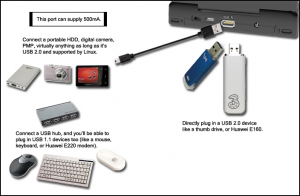Difference between revisions of "USB reference"
(Added USB High Speed logo for reference, and cleaned up text in this section.) |
(→So which devices are USB 1.1, and which ones are USB 2.0?: Not sure webcams are 1.1) |
||
| Line 26: | Line 26: | ||
[[Image:USB-HighSpeed-certified-Logo.png|thumb|alt=USB High Speed Certified logo|Devices bearing this logo are certified High Speed devices. They can be plugged directly into Pandora's USB 2.0 host port.]] | [[Image:USB-HighSpeed-certified-Logo.png|thumb|alt=USB High Speed Certified logo|Devices bearing this logo are certified High Speed devices. They can be plugged directly into Pandora's USB 2.0 host port.]] | ||
There are no set rules. As a very general guide: | There are no set rules. As a very general guide: | ||
| − | * Common USB 1.1 devices include keyboards, mice | + | * Common USB 1.1 devices include keyboards, mice, headsets, older USB devices. |
* Common USB 2.0 devices include cameras, PMPs, HDDs, hubs, card readers, thumb drives. | * Common USB 2.0 devices include cameras, PMPs, HDDs, hubs, card readers, thumb drives. | ||
This is just a rough representation of what’s out there in the wild, and you will find exceptions. Devices like HSDPA modems and GPS units could fall into either category. The only reliable indication of true USB 2.0 compatibility is the “USB High Speed Certified” logo (right). | This is just a rough representation of what’s out there in the wild, and you will find exceptions. Devices like HSDPA modems and GPS units could fall into either category. The only reliable indication of true USB 2.0 compatibility is the “USB High Speed Certified” logo (right). | ||
Revision as of 20:56, 25 October 2009
Contents
- 1 Readme First!
- 2 USB FAQ
- 2.1 How many USB ports does Pandora have?
- 2.2 What does “host port” mean?
- 2.3 What does “OTG” mean?
- 2.4 What’s all this stuff about USB 1.1 and USB 2.0? Isn’t USB, uh, universal?
- 2.5 So which devices are USB 1.1, and which ones are USB 2.0?
- 2.6 Arrgh, USB used to be simple. What can I actually connect to Pandora?
- 3 Pandora as USB slave
- 4 Hosting USB devices
- 5 OTG host mode
- 6 Links
Readme First!
If you have a question to ask, that isn't covered in this FAQ already, please ask over on the Forums.
USB FAQ
How many USB ports does Pandora have?
Pandora has two USB ports:
- 1x USB 2.0 host port (USB standard-A receptacle)
- 1x USB 1.1/2.0 OTG port (USB mini-AB receptacle)
What does “host port” mean?
A USB host port “hosts” any device that you plug in, just like the USB ports on your computer. Pandora’s full size USB A port can host USB 2.0 devices, and provide up to 500mA (the maximum allowed according to USB standards).
What does “OTG” mean?
OTG stands for On The Go. USB OTG ports can operate in two different modes. When connected through this port, the Pandora can act as a device, for example when connected to a computer for charging & data transfer. For this mode, you need a standard-A to mini-B cable. However, the Pandora can also act as a host port for USB 1.1 and USB 2.0 devices. For details on how to make the necessary cable connection, see the OTG host mode section. This port can supply a maximum of 100mA in host mode. Although this port implements On The Go functionality, it can not get an official On The Go certification because the OTG specification requires a device to have exactly one USB port. (The Pandora has two.) Also, the mini-AB connector used on the Pandora has been taken out of the specification in 2007 (but is still widely adopted).
What’s all this stuff about USB 1.1 and USB 2.0? Isn’t USB, uh, universal?
The USB 2.0 protocol is not backwards compatible with USB 1.1. Most USB ports (eg. on your computer’s motherboard, in USB hubs) actually contain two chips to allow universal compatibility – one for USB 1.1, and one for USB 2.0.
Pandora’s USB standard-A host port does not contain this second chip. Only USB 2.0 devices bearing the “USB HIGH SPEED” logo can be plugged directly into this port. However, USB 1.1 devices can be connected to this port through a USB hub, provided the hub bears the “USB HIGH SPEED” logo.
Pandora’s USB OTG (mini-AB) port is fully compatible with both USB 1.1 and USB 2.0, allowing it to host either type of device.
So which devices are USB 1.1, and which ones are USB 2.0?
There are no set rules. As a very general guide:
- Common USB 1.1 devices include keyboards, mice, headsets, older USB devices.
- Common USB 2.0 devices include cameras, PMPs, HDDs, hubs, card readers, thumb drives.
This is just a rough representation of what’s out there in the wild, and you will find exceptions. Devices like HSDPA modems and GPS units could fall into either category. The only reliable indication of true USB 2.0 compatibility is the “USB High Speed Certified” logo (right).
Arrgh, USB used to be simple. What can I actually connect to Pandora?
Almost anything, as long as it's supported by Linux. Think of a USB device that everybody uses (mouse, keyboard, thumb drive...) and chances are it will be a simple matter of plug and play. But this might not be the case for more specialised USB devices (modems, ethernet adapters, USB displays...), many of which will only function with Windows specific drivers.
If you intend to purchase USB accessories for use with Pandora, you should first research Linux support for that type of device. Devices already tested on Pandora will be added to the USB compatibility list.
The various USB connection scenarios are as follows:
Pandora as USB slave
Using a USB standard-A to mini-B cable (the kind you probably own several of), you can:
- Transfer data to/from Pandora
- Charge Pandora's battery.
Note:
- Charging Pandora from your computer's USB port is best done with Pandora in standby mode, or switched off. The current provided by your computer will probably not be sufficient to provide an effective charge while Pandora is being used.
Hosting USB devices
- Directly plug in a USB 2.0 device such as a thumb drive, or a Huawei E160 modem.
- Using a USB standard-A to USB standard-B (or mini-B, micro-B, depending on what's on the device) cable, connect USB 2.0 devices such as cameras, PMPs, and HDDS.
- Connect a USB hub, which will enable you to to connect USB 1.1 devices such as keyboards, mice, or a Huawei E220 modem.
Note:
- This port can supply a maximum of 500mA. If you plan to use a USB HDD, note that very few of these can draw sufficient power from a single USB port. A powered HDD caddy or powered USB hub will be necessary in most cases.
OTG host mode
How you connect a device to the mini-AB OTG port depends on the device's USB connector.
- standard-B receptacle: Use a mini-A to standard-B cable.
- mini-B receptacle: Use a mini-A to mini-B cable.
- micro-B receptacle: Use a mini-A plug to standard-A receptacle adapter and a standard-A to micro-B cable.
- standard-A plug: Use a mini-A plug to standard-A receptacle adapter.
- mini-A plug: No extra cable or adapter needed.
- micro-A plug: No standardized solution exists.
This port allows you to connect a USB 1.1 device directly, without the use of a hub. This port is also USB 2.0 compliant.
Notes:
- mini-A and mini-AB connectors have been removed from the present USB standard. This means that the above connectors may vanish from the market at some point (although there will probably be demand for them for some time). There are a lot of connectors available that were never standardized. It is recommended that you do not use them as they may lead to non-working connections. Stick to the cables and adapters mentioned above and look for a mention of "OTG" or "On The Go" and you should be on the safe side.
- In host mode, this port can supply a maximum of 100mA. USB 1.1 devices that draw more than 100mA will need to connect to Pandora's other USB port via a hub, as depicted in the previous example. The Huawei E220 is one such device.



